Trip to Berlin
Reise nach Berlin
by N. Richard Wagner
Copyright © 2006 by N. Richard Wagner, all rights reserved.
The Holocaust Memorial
The official title of the Berlin Holocaust Memorial is: Denkmal für die emordeten Juden Europas (Memorial for the murdered Jews of Europe). I had heard so much about this memorial that it was at the top of my list of new Berlin constructions to see. I spend an hour wandering around in the memorial on a nice afternoon. I skipped the museum because of the long line waiting to get in. My own reactions were not strong or profound except for one "inappropriate" response. The memorial is deliberately repetitive, with the only variations being the height and tilt of the stones, and the uneven (wavy) walkways. I found myself wishing for a variation, and then I came upon one of the emergency exits from the museum below. This was such a welcome interruption, that I began hoping for a bright yellow stone, or something equally startling. Of course the architect wanted nothing like that, and I'm sure didn't even want the emergency exits. I was wondering if he could have included a deep pit at the center, or at least some holes to fall into.
Physically the memorial "consists of 2711 stones placed on sloping, uneven ground in an undulating wave-like pattern," in an area of 19000 square meters, or 5.5 acres. The stones are called Stelen (singular die Stele) in German, but "Stele" is also an English word: "a stone or wooden slab, generally taller than it is wide, erected for funerary or commemorative purposes" [Wikipedia]. Each of these granite stones (average weight of 8 tons) is 2.38 meters long and 0.95 meters wide. The height varies from 0 (even with the ground) to 4.7 meters. They are arranged in 54 columns (North-South) and 86 rows (East-West), and although 54*86 = 4644, a number of the rows and columns are nearly empty, as one can see in the pictures below. All the paths through the stones are 0.95 meters wide, the same as the width of a stone. The stones are not placed exactly vertically, but are deliberately tilted in different directions by 0.5 to 2 degrees. The total construction costs were 27.6 million Euros.
The memorial also includes an underground museum, with a list of all known Jewish victims of the Holocaust, among other displays. Along the western side of the memorial 40 trees were added to the design. The trees and the museum were included against the wishes of the architect, Peter Eisenman, a Jewish American born in New Jersey.
This museum was added after criticisms of the memorial such as the following, although this particular criticism was made after everything was finished:
At the opening ceremony on May 10, 2005, Paul Spiegel, the head of Germany's Central Council of Jews, sharply criticized the new Holocaust memorial, saying that it was too abstract and that it failed to confront the issue of German guilt. In his speech, Spiegel said that the Memorial for the murdered Jews of Europe honors the victims of Nazism, but the Memorial does not refer directly to the perpetrators. According to Spiegel, viewers are not confronted with questions of guilt and responsibility. Spiegel complained that the Memorial leaves an "incomplete message" and merely shows the Jews "as a nation of victims poured into 2,711 concrete pillars." Spiegel said that the Monument fails to ask the question "Why?"
Other criticisms focus on the absence of all the other peoples murdered during the Holocaust.
The stones have been treated on the surface with chemicals so that graffiti can be more easily removed. In 2003 a controversy erupted when it was discovered that the firm supplying the chemicals, Degussa AG, is a continuation of the firm Degesch that manufactured the chemical Zyklon B used to kill Jews in concentration camps. In the end the company Degussa AG was found to have atoned for the past and this controversy was ignored.
My son John objected to the fairly obvious symbolism of a place where one can easily wander in, and then easily get to where the stones are above ones head, feeling lost and confused. He didn't like the idea that this might be seen as a German justification -- that Germans somehow "wandered in" to the Holocaust without realizing it.
Other Germans mentioned the harsh juxtapositions near the memorial -- traffic and buildings all around, including expecially the "fortress" of an American embassy on the north side of the memorial. A tremendous amount of material on the internet covers all these questions, as well as the book cited below. One comment that stuck in my mind was made during the dedication -- that some visitors did not know what was being memorialized, and that such people would nevertheless realize that something very serious and important was at issue.
In my own year-long stay in Germany during 1962 to 1963, I was naturally interested in German reactions to issues about the war and especially about the Holocaust. (I was a 22-year-old mathematics student at the time.) Various German friends of about my age patiently explained that they were 5 years old (or whatever age) at the end of the war, and had had nothing to do with it. They had a feeling of shame about the events of the war, but not of guilt. Another common reaction from young Germans at that time was a general disinterest in the whole subject, since they had heard so much about it and had discussed it so much. One time in the Spring of 1963, I was staying in a Youth Hostel in Germany. The first night, the males were settled into beds in a dormitory -- all were college students except for one weird older man from Austria who had signed in as a Sexualpsychologe (a sexual psychologist), a fact which heightened the interest of the students in him. As people were talking in the dark, he said that Germans would all be happier marching along behind a flag again. This provocative remark led to an interesting discussion, mostly a strong refutation of his statement by the others.
When I got to Germany in 1962, I stayed with a German family for the first month, before the Winter term at the university started. This family consisted of a son roughly my age, and his mother and grandmother, roughly the age of my mother and grandmother. During one of many discussions, his mother told me how her father had died in World War I when she was just a little girl and how her husband had died in World War II after just a few years of marriage, so that the two wars had pretty much trashed her whole life. It wasn't till then that I realized the degree to which the Germans also suffered as a result of the wars. This lady also talked with me about the unrelenting German propaganda against the Jews during the war, in which Goebbels and those under him blamed all wartime hardships on the Jews.
Once a fellow student at the University of Hamburg (die Universität Hamburg) told me that Hitler had never dared to visit Hamburg, sort of implying that Hamburg was a liberal place that never embraced Nazism. Later I found out that this was nonsense; Hitler gave speeches in Hamburg.
So what is the balance I would draw in trying to evaluate this Holocaust Memorial? Well, it's certainly powerful. The understatement, and absence of actual statement or direct meaning adds to the power. But still I feel that it is overly large and repetitive. One could compare it to the portion of the Jewish Museum in Berlin called Der Garten des Exils und der Emigration (the Garden of Exile and Emigration). This consists of 49 towers (also called Stelen like the stones in the Holocaust Memorial) arranged in a 7-by-7 square grid. These towers are built on sloping land and stick up at an angle, so that there is a feeling of disorientation. The two different memorials serve different goals, but I can't help but see the "Garden" as more modest and yet more effective.
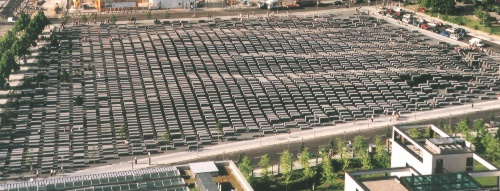 |
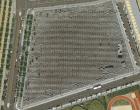 |
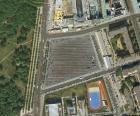 |
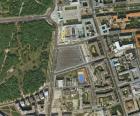 |
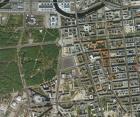 | |||
| The Holocaust Memorial (aerial views) | ||||||
|---|---|---|---|---|---|---|
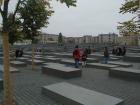 |
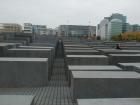 |
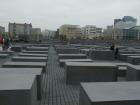 |
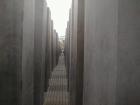 | |||
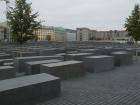 |
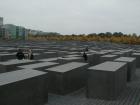 |
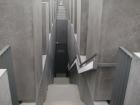 |
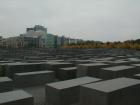 | |||
| The Holocaust Memorial (ground views) | ||||||
|---|---|---|---|---|---|---|
Hans-Georg Stavginski has written a book about the entire background and history of this Holocaust Memorial. The title is: Das Holocaust-Denkmal: Der Streit um das Denkmal which translates to: The Holocaust Memorial: the Discord Over the Memorial. Published by Ferdinand Schningh Verlag, June 2005, 357 pages. A review in English by Peter Rosenbaum of The Remarque Institute, New York University, was published in H-Net Reviews of the Humanities and Social Sciences. This review covers many of the conflicts involved in finishing this memorial.
Here is a link to pictures and commentary about the Holocaust Memorial. (Includes a "Personal Perspective" by an American Ph.D. history student, Bonnie M. Harris, who was studying Holocaust sites all through Europe.)